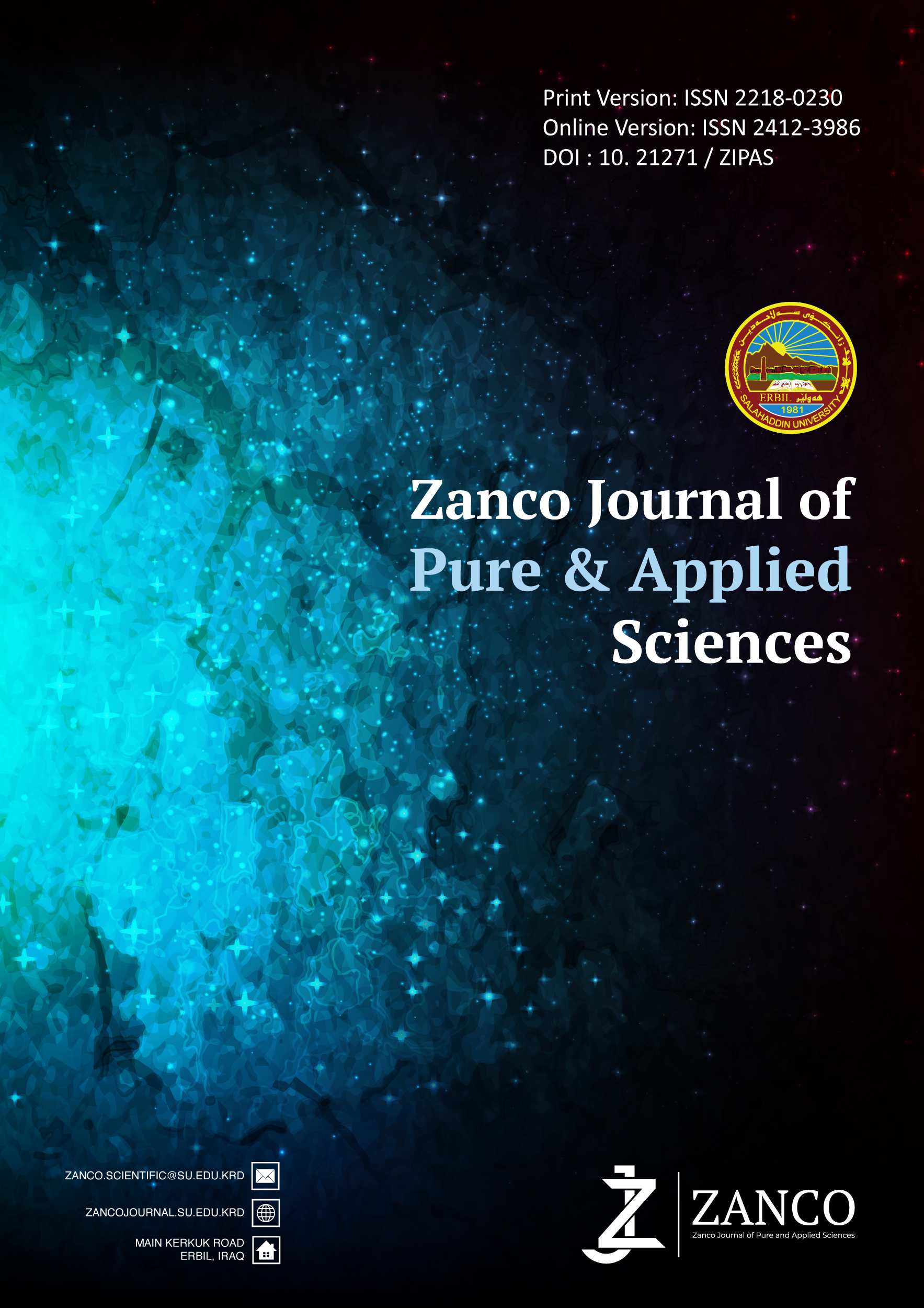Climatic Parameters Use for Evaluating Water Budget and Drought Analysis in Erbil Sub-basin, Kurdistan Region, Northern-Iraq
DOI:
https://doi.org/10.21271/ZJPAS.36.5.5Keywords:
Water Budget; Runoff analysis; WMS; Drought analysis; SPI.Abstract
Major theoretical and practical hydrological issues may be solved using methods to maintain water balance. Evaluating the climate characteristics and environmental circumstances to be employed in the methods of water managing approach used in the Erbil sub-basin, northern Iraq, is the primary goal of this study. The studied area is a part of the region influenced by the Mediterranean climatological system. The climatic parameters of the research region were evaluated using the climatic data collected in the Erbil meteorological station for the period 1980-2022. The research result shows that the mean annual rainfall is 411.26 mm/year and the average monthly relative humidity is 41.12 %, the mean temperature is 20.62 °C, mean sunshine duration 8.35 hr./day and annual pan evaporation is 1200.96 mm / year. Potential evapotranspiration considered by Thornthwaite method is 1588.94 mm. The water surplus and deficit are 216.14 mm and 1393.81 mm, respectively. The surface runoff calculating from soil conservation system (SCS) technique which is about 86 mm / year and groundwater recharge is about 130.14 mm / year. The groundwater Budgets is about 187661880 m3 / year. The climatic situation in the area is variety from winter its wet to the summer its dry climates. Also, it could be measured that the climate in the area is determined was (Humid to very humid). The draught index according to SPI analysis show that the drought was observed during Moderately drought in (1983, 1999, 2000, 2010, 2015, and 2021) to severely drought in (2022.
References
AL-DABBAS, M.A. AND ABDULLA, M.A., 2019. Climatic water balance for Ishaqi area, Salah Al-dean governorate, Iraq. The Iraqi Geological Journal, pp.105-115.
AL-KUBAISI, Q. Y., 2004. Annual aridity index of type.1 and type.2 mode options climate classification. Iraqi Journal of Science, pp. 32-40.
Al-Kubaisi, M.H. and Al-Kubaisi, Q.Y., 2022. Applying SWAT model to estimate the annual runoff of Wadi Al-Mohammadi Basin, Western Iraq. The Iraqi Geological Journal, pp.189-200.
ANDERSON, M.P., WOESSNER, W.W. AND HUNT, R.J., 2015. Applied groundwater modeling: simulation of flow and advective transport. Academic press.
DARA, R.N., JIRJEES, S., FATAH, K.K. AND JAVADINEJAD, S., 2021. Climatic Parameters Analysis of Koysinjaq Meteorological Station, Kurdistan Region, Northern Iraq. The Iraqi Geological Journal, pp.99-109.
DEO, R.C., SALCEDO-SANZ, S., CARRO-CALVO, L. AND SAAVEDRA-MORENO, B., 2018. Drought prediction with standardized precipitation and evapotranspiration index and support vector regression models. In Integrating disaster science and management. Elsevier, pp. 151-174.
JASSIM, S.Z. AND GOFF, J.C. EDS., 2006. Geology of Iraq. DOLIN, sro, distributed by Geological Society of London.
JAVADINEJAD, S., DARA, R., JAFARY, F., 2019. Effect of precipitation characteristics on spatial and temporal varia-tions of landslide in Kermanshah Province in Iran. Journal of Geographical Research, 2(4).
JIRJEES, S., SEEYAN, S. AND FATAH, K., 2020. Climatic analysis for Pirmam area, Kurdistan Region, Iraq. The Iraqi Geological Journal, pp.75-92.
JIRJEES, S.J., HASSAN, I.O. AND SEEYAN, S.O., 2022. Hydrometeorological Data Analysis and Drought Indices of Rawandoz Area, Iraqi-Kurdistan Region. Zanco Journal of Pure and Applied Sciences, 34(6), pp.150-159.
JIRJEES, S.J., HASSAN, I.O. AND SEEYAN, S.O., 2022. Hydrological Study Using Remote Sensing and GIS in Rawanduz Sub-Basin, Erbil, Kurdistan Region, Iraq.
KETTANEH, M.S. AND GANGOPADHYAYA, M., 1974. Climatological Water Budget and Water Availability Periods of Iraq.
LIVADA, I. AND ASSIMAKOPOULOS, V.D., 2007. Spatial and temporal analysis of drought in Greece using the Standardized Precipitation Index (SPI). Theoretical and applied climatology, 89, pp.143-153.
MAIDMENT, D., 1993. Handbool of Hydrology. New York.
MCKEE, T.B., DOESKEN, N.J. AND KLEIST, J., 1993, January. The relationship of drought frequency and duration to time scales. In Proceedings of the 8th Conference on Applied Climatology, Vol. 17, No. 22, pp. 179-183).
MOHAMMED, A.S., SAID, M.A.M., KAMEL, A.H. and ABDULLAH, R., 2022. Develop Evaporation Model Using Multiple Linear Regression in the Western Desert of Iraq–Horan Valley. Journal homepage: http://iieta. Org /journals / ijdne, 17(1), pp.137-143.
RAFAAT, O., A AND HAMEED, M., H., 2023. Hydrological Study of Catchment Area of Proposed Bastora Dam, Erbil Governorate-Iraqi Kurdistan Region.
SINGH, N.K., EMANUEL, R.E., MCGLYNN, B.L. AND MINIAT, C.F., 2021. Soil moisture responses to rainfall: Implications for runoff generation. Water Resources Research, 57(9), p.e2020WR028827.
SONG, S. AND WANG, W., 2019. Impacts of antecedent soil moisture on the rainfall-runoff transformation process based on high-resolution observations in soil tank experiments. Water, 11(2), p.296.
SUBEDI, A. AND CHÁVEZ, J.L., 2015. Crop evapotranspiration (ET) estimation models: a review and discussion of the applicability and limitations of ET methods. Journal of Agricultural Science, 7(6), pp.50.
THORNTHWAITE, C. W., 1948. An approach toward a rational classification of climate. Geog. Rev., 38, pp. 55–94.
THORNTHWAITE, C. W., AND WILM, H. G., 1944. Report of the committee on transpiration and evaporation. Trans. Amer. Geophysical. Union, 5, pp. 683-693.
WANG, Z., CUI, Z., HE, T., TANG, Q., XIAO, P., ZHANG, P. and WANG, L., 2021. Attributing the Evapotranspiration Trend in the Upper and Middle Reaches of Yellow River Basin Using Global Evapotranspiration Products. Remote Sensing, 14(1), pp.175.
Downloads
Published
How to Cite
Issue
Section
License
Copyright (c) 2024 Shevan Jameel Jirjees

This work is licensed under a Creative Commons Attribution 4.0 International License.














